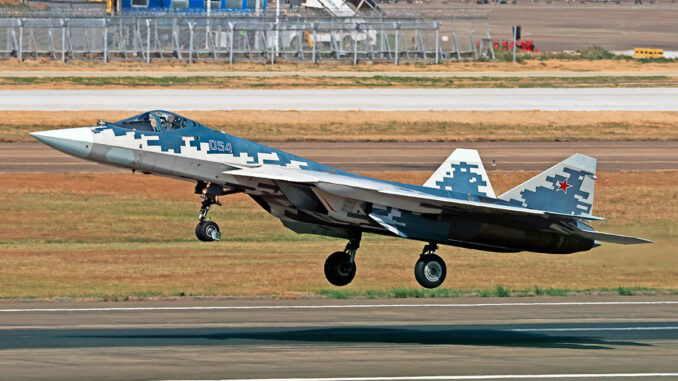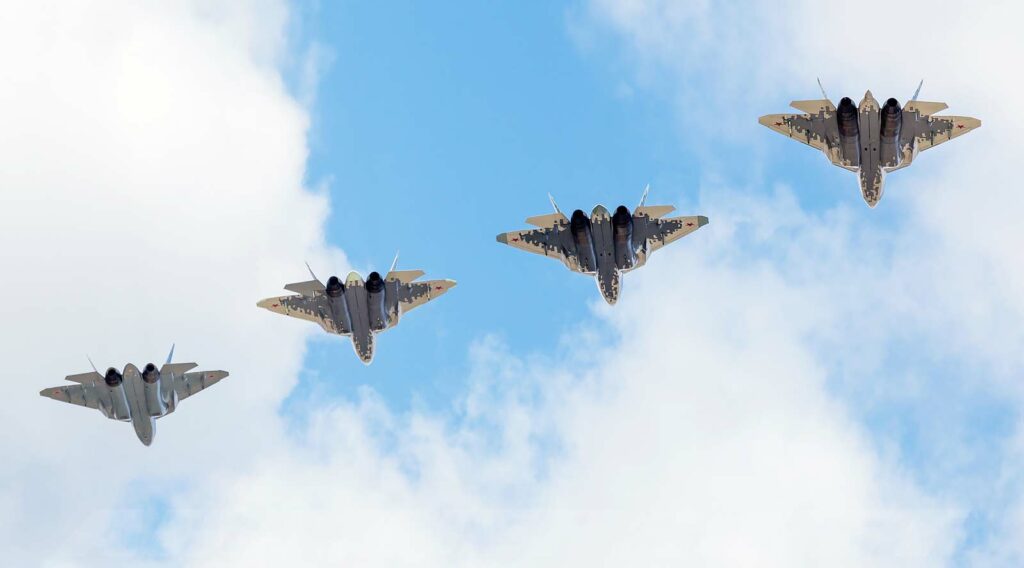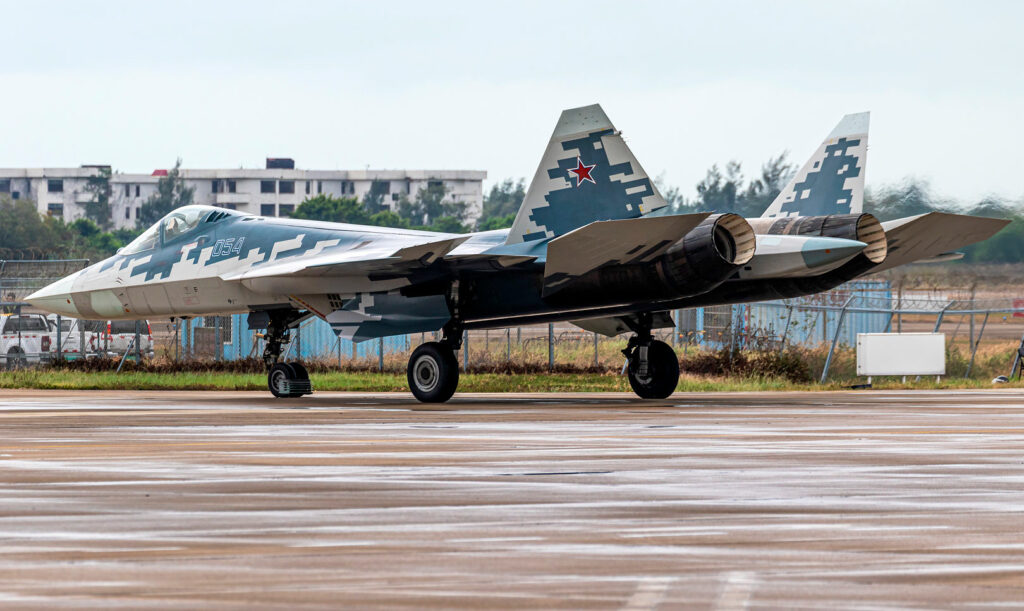
Documents reveal that the Russian Su-57 fighter jet has been delivered incomplete, without key systems, affecting its performance, costs, and commercial future.
A recent analysis of confidential documents reveals significant shortcomings in deliveries of the fifth-generation Su-57. The Su-57 fighter jet is being handed over to the Russian Air Force without certain crucial systems. These omissions, attributable to Western sanctions, are generating additional costs and delays, and undermining the program’s effectiveness. This technical article describes in detail the missing systems and their operational, commercial, and reputational consequences.
The 101KS-N electro-optical system is missing
Revelations from industrial audits indicate that several examples of the Russian Su-57 were delivered without the 101KS-N electro-optical module, a central component of the 101KS “Atoll” optronic complex. This system is designed to provide passive infrared and electro-optical detection capabilities, enabling the identification of air and ground targets without radar emissions. It integrates a high-resolution infrared channel, a laser rangefinder, and a low-light TV camera, making it an essential sensor for air superiority and all-weather engagement.
Its absence deprives the Su-57 fighter jet of critical functions such as accurate ground target designation, the ability to guide precision munitions, and improved survivability through passive threat detection. Each unit, estimated to cost between $3.2 million and $4 million, represents a significant portion of the aircraft’s overall cost. The contractual separation imposed by the Russian Ministry of Defense allowed for the delivery of airframes without this module, with a subsequent commitment to retrofit it. However, this practice has created a risk of double billing, delays in operational commissioning, and increased dependence on a supply chain weakened by Western sanctions.

Origin of delays and inflated costs
The production line for the Su-57 in production was severely affected by the halt in Western deliveries of critical components, including semiconductors, high-performance microelectronics, certain miniaturized power supplies, and advanced radar modules. These components, previously imported from European and Asian suppliers, were essential for onboard computers, electronic warfare systems, and the N036 Byelka AESA radar. Their absence led to structural delays, forcing Russian manufacturers to resort to less efficient local substitutes or to adapt civilian components, which lengthened qualification times.
Audits carried out in 2025 at the Komsomolsk-on-Amur plant, the main assembly center for the Su-57, revealed opaque accounting practices. Military and civilian orders were deliberately mixed together, allowing costs to be transferred from one program to another. This process served to mask the additional costs associated with sanctions and artificially present a continuity of production. In reality, this management resulted in inflated prices for the Russian Ministry of Defense, while creating hidden cross-subsidies. The final impact is a unit cost for the aircraft that is significantly higher than initially forecast and a considerable delay in the delivery schedule.
Impact on combat capabilities
The absence of the 101KS-N module significantly reduces the effectiveness of the Russian stealth fighter in operations. This sensor was supposed to provide passive targeting capability day and night, enabling the identification and designation of ground and air targets without the use of radar. Without this capability, the fifth-generation Su-57 loses some of its stealth and versatility advantages. Its pilots must rely more on active radar sensors, increasing the risk of detection by enemy systems.
In ground strikes, the lack of electro-optical designation degrades the accuracy of guided munitions and limits engagement capabilities in complex weather conditions or at long ranges. This limitation was observed during its limited deployment over Ukraine, where the Su-57 was relegated to peripheral missions, such as firing cruise missiles from Russian airspace, rather than entering the contested zone directly. The air force therefore favored proven platforms such as the Su-35 and Su-30, which are equipped with more robust and better integrated systems. This situation illustrates a paradox: the most advanced aircraft in the Russian fleet remains underutilized due to the lack of key components.
Derisory production rate
The Su-57 program is hampered by a particularly low industrial production rate, revealing the technical and financial constraints weighing on the aircraft manufacturer. By the end of 2024, only around seven units had been delivered to the **Russian Air Force, and fewer than *20 units* of the Su-57 were operational at the beginning of 2025. This figure is still a long way from the 76 aircraft initially promised for 2027-2028. This slowdown is due to difficulties in stabilizing production lines at the Komsomolsk-on-Amur plant, which is facing a shortage of imported components and longer-than-expected test cycles.
Each airframe requires complex assembly of sensitive electronic equipment, some of which is still being replaced by domestic alternatives. These delays are reducing the aircraft’s operational availability and limiting its integration into existing fighter regiments. Pending more sustained production, Russia is maintaining a symbolic fleet, which is insufficient to influence the air power balance with NATO fleets. The contrast between the stated ambitions and the industrial reality undermines the credibility of the development of the Su-57 and raises questions about Moscow’s ability to meet its contractual commitments.
Weakened cost and export strategy
The announced cost of the Russian Su-57 is between $37 million and $42 million per aircraft, but this estimate does not include the delayed integration of missing systems, such as the 101KS-N or certain radar modules. Their subsequent addition will entail additional costs that could significantly increase the final bill. This lack of transparency regarding pricing directly undermines the competitiveness of the Su-57 in production on the international market.
Campaigns to promote exports of the Su-57 have been conducted in countries such as Algeria and India, but without concrete results. Potential buyers are concerned about delays in the Su-57, its status as an incomplete aircraft, and the lack of feedback from real combat conditions. The Russian offer, based on partial industrial transfer and shortened delivery times, fails to compensate for these shortcomings. This weakens the commercial strategy and limits the prospects for a breakthrough in exports, leaving uncertainty about the future of the Su-57 outside Russia.
Tarnished reputation
The Russian Su-57 was supposed to be the technological showcase of Moscow’s aviation industry, capable of competing with the Western F-22 Raptor and F-35 Lightning II. However, deliveries of incomplete aircraft and production delays have undermined this image. The absence of critical systems such as the 101KS-N and certain electronic components reduces the credibility of the Su-57 fighter jet as a fully operational fifth-generation platform. This situation has raised doubts not only within the Russian armed forces, but also among foreign partners considering a possible purchase.
The decision to limit the Su-57’s involvement in the war in Ukraine illustrates this fragility. The aircraft has remained in the background, used for long-range cruise missile strikes, but rarely exposed to a contested environment, unlike the American F-35s, which are regularly deployed in operations. This caution reflects fears that one of the aircraft could be shot down, exposing its sensitive technology to adversaries and causing a symbolic disaster for Moscow. Against this backdrop, the Su-57’s reputation has deteriorated to the point of damaging its international appeal, while the future of the Su-57 remains uncertain and dependent on industrial fixes that are still hypothetical.
Mitigation attempts
Faced with these difficulties, Moscow has launched the development of the Su-57M, a modernized version intended to correct the shortcomings of the initial model. This upgrade includes the new-generation Izdeliye 30 engine, offering increased thrust and improved reliability, as well as an upgraded AESA radar and AI-based flight control systems. The aim is to bring the aircraft up to international standards, while reducing its dependence on Western components banned by sanctions.
However, deliveries of this variant remain very limited and will not enable the Russian Air Force and the Su-57 to be equipped quickly. The replacement of imported technologies with domestic equivalents remains incomplete, particularly in the field of microprocessors and optronics. Furthermore, the announced capabilities are still based on prototypes whose reliability in series production has not been demonstrated. These limitations fuel uncertainty about Russia’s ability to transform the Russian stealth fighter into a credible and exportable operational tool, while international competition continues to advance rapidly.

An uncertain offer to India
Moscow is offering India co-production of the Su-57E with unfinished engines, partial localization (40 to 60%), and rapid deliveries—promises that are considered unrealistic given current production capacity.
Technical summary of impacts
| Element | Current situation |
|---|---|
| 101KS-N system | Obsolete, source of expensive armor |
| Production | Fewer than 20 aircraft delivered, low rate |
| Operational capabilities | Limited, less effective ground strikes |
| Cost | ~$40 million without key systems, inflated costs |
| Export | None or very limited, weakened competitiveness |
| Reputation | Weakened, credibility called into question |
What this means for the future
The Russian stealth fighter is at an impasse: prestigious technology but imperfect implementation, previous delays, and financial and industrial pressures. The program remains dependent on foreign technologies and stable industrial integration. The future will depend on the success of substitution efforts and the gradual restoration of capabilities.
War Wings Daily is an independant magazine.